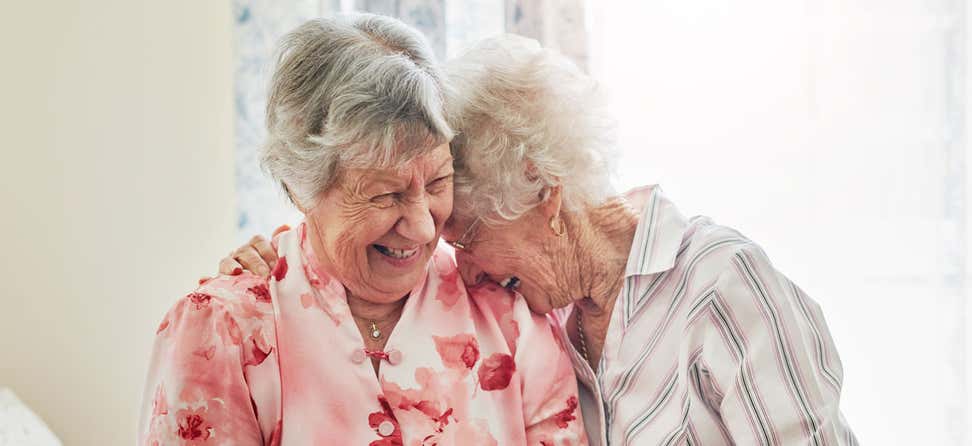As Chinese Americans are aging in the community, we have the opportunity to develop culturally tailored health information in older adults’ preferred languages to overcome barriers associated with limited English proficiency and low health literacy. Community-based health promotion programs focused on chronic disease self-management education (CDSME), falls prevention, physical activity, and mental and behavioral health enable older adults to take control of their health and well-being.
Chinese Americans comprise the largest segment (24%) of the Asian American population in the United States.1 Nearly 70% of Chinese Americans are immigrants, and 81% speak Mandarin or Cantonese at home.2
According to data collected nationally from local CDSME programs funded by the Administration for Community Living, and housed in the Healthy Aging Programs Integrated Database (HAPID®), approximately 4% of all program participants identify as “Asian American.” “Chinese American” is not specified on the data collection tools. Asian American CDSME participants tend to be older, less likely to live alone, and more likely to be caregivers than participants overall.
To learn more about strategies for successfully serving Chinese American communities with chronic disease self-management education and falls prevention programs, we talked to leaders from the California-based On Lok, and the Massachusetts-based EACH and AgeSpan.
On Lok-30th Street Senior Center (California): Serves a community of 6,700 adults in San Francisco with a variety of community-based services including evidence-based programs.
- Ken Wong, Healthier Living Program Specialist
- Astrid Chen, Chronic Disease Self-Management Education Program Leader
Enhance Asian Community on Health (EACH) and AgeSpan (Massachusetts): EACH has served participants in Boston since 2014. Prioritizing their core values of compassion, integrity, dignity, and respect, EACH provides programs focused on prevention and wellness, financial security, arts and culture, and community advocacy. AgeSpan connects people of all ages and abilities with information and services to help them lead fulfilling lives in the community.
- Sara Tan, Executive Director, Enhance Asian Community on Health (EACH)
- Melissa Donegan, Director, Healthy Living Center of Excellence, AgeSpan
“We found that AgeSpan had very, very good health and wellness programs that Asian Americans were missing. We think this is very important for our older adults. We looked at the programs and how we could help our community, but all of the programs were in English.”- Sara Tan
Bridging language gaps
Overcoming language barriers is essential for connecting Chinese American older adults with health promotion opportunities. In exploring available evidence-based programs and more broadly, health and wellness information, resources are less frequently available in Chinese. The language barrier is a significant hurdle in delivering effective evidence-based programs.
In order to make the Chronic Disease Self-Management Program (CDSMP) accessible to the Chinese American community in the Greater Boston area, Tan and her colleague completed the Master Trainer training and took the initiative to train local lay leaders in Cantonese. This expertise empowered EACH to train leaders in their own language and the language that would be used for the workshops. It also eliminated the burden of expecting leaders to complete training in English and translate the training materials and curriculum as they progress through the class. This opened the door to pursuing training for a large menu of programs available in Massachusetts and ensuring they are implemented in Chinese with trusted leaders.
“People are suffering from chronic diseases. Not many people are running the program in Chinese. And I said to myself, ‘what can I do?’ I want to contribute to society. Health is the most important thing for our older adults. They are suffering and no one is helping them in their language. If I don’t learn it too, I don’t know what’s happening.”- Tan
Language translation is complex. As community-based organizations are identifying peer leaders, it’s invaluable to engage leaders who are able to maintain the natural flow and meaning of the original content for clear communication.
To assist in leading classes, EACH and On Lok connected with CDSMP leaders in Hong Kong to obtain a copy of the CDSMP class materials in Chinese. However, having a translated manual is only the tip of the iceberg. There is also the need for linguistically appropriate marketing and recruitment materials, participant communications, and data collection materials. On Lok even translated the audio CD and PowerPoint included in the Chronic Pain Self-Management virtual program.
As the statewide hub for evidence-based programs in Massachusetts, AgeSpan relied on EACH to guide linguistically and culturally appropriate implementation of CDSMP. Without the understanding and capacity to provide the programs by the right leaders and in the right languages, they would not be a success. Donegan applauds Tan's dedication, highlighting the high level of effort, and resources needed to have success.
"Sara's completion rates for programs are 100% or very close to it all the time," Donegan said about Tan. "No matter what program she is doing, like Healthy IDEAS, Matter of Balance, or CDSMP. It’s because of the amount of time they spend, and the resources invested in hosting ‘session zeros,’ calling people with reminders, knocking on doors in residential buildings to remind people that workshops are starting. The secret ingredient is resources. Making sure that the marketing and everything you’re putting out there is meaningful."
Nurturing strong leaders to provide culturally sensitive programs
As Chinese American communities adopt evidence-based programs, it's critical to consider how cultural references can be embedded in marketing, development of relationships with community members, and facilitation of programs.
On Lok and EACH both focus on training leaders from the community, who can facilitate classes in participants’ preferred languages and naturally incorporate appropriate cultural references for foods, physical activities, and social connections. For example, Chen learned about CDSMP through her mother. Her mother had volunteered with On Lok as a peer leader and needed a translator to complete the training provided in English. Chen joined the training to translate the material from English to Cantonese, and was impressed by the curriculum. She now facilitates CDSMP workshops in Cantonese and English over Zoom.
Chen sees opportunities for having impactful conversations during the workshops that truly resonate with Chinese participants. She pointed out the discussions her classes often have around nutrition,
“The healthy eating section is very interesting. Participants love to read the nutrition labels," Chen said. "I intentionally bring out the seasonings and sauces that they love to use a lot—soy sauce, hoisin sauce. It may taste sweet, but the sodium level is very high. We problem solve around, ‘how can you cook your meal with less sodium and still make it tasty?’ It’s hard to change habits, but sometimes they come back and say, ‘I tried something new and it tasted really good.’”
A lot Chinese seniors that join these programs live in senior communities. They live alone and don’t always see their children often. These programs give them encouragement and hope. They can manage their health. I tell them that they can be responsible citizens by taking care of themselves and contribute to the community.”- Astrid Chen
She also shared the importance of conversation skills and strategies for improving interpersonal communication taught through CDSMP.
“I grew up in a Chinese family and I know that communication is lacking," Chen said. "It is so important to discuss that the way you talk makes a difference. Try to understand what your partner or family member is trying to communicate. Don’t make assumptions, and actively listen. This is very important for the Asian community. To learn how to communicate and say what we really think and feel with honesty. Participants tend to shy away from talking about mental health, but this is a start.”
Providing a variety of classes in Chinese, with leaders who understand cultural nuances, in locations where older adults have easy access, like housing sites, has increased the demand for health promotion programs drastically.
“We’ve done every program at every site and then participants will say, ‘let’s do it all over again,’" Tan said. "Sometimes there’s a class in the morning and a class in the afternoon to accommodate everyone. The demand is so high. The participants won’t let us go. They say, ‘you better not finish the program. Let’s start again.’”
7 best practices for leading culturally relevant programs:
- Nurture strong leaders to provide culturally sensitive programs: Strong program leaders are passionate about serving their community and bringing the best health and wellness information to Chinese older adults. Respect their efforts to grow and lead engaging programs. Attend the events and classes they host in person to show gratitude.
- Encourage cultural references: Ask leaders to take cultural considerations into account when implementing the program (For example, incorporating cultural examples of food). When a site uses “session zero” to introduce CDSMP for Chinese participants, On Lok modifies the “ice breaker” activity to ask about participants' favorite soup versus their favorite food in general to recognize an important part of food culture. Nutrition discussions may also focus on food staples like rice and noodles or common seasonings.
- Centering family: Family is very important in the Asian community. Always consider ways to include family members and loved ones. As programs are marketed, encourage people to attend with their spouse or other family members. Talk about how participants can share their progress with children or grandchildren.
- Include traditional activities: Before and after classes, On Lok incorporates culturally relevant activities, like singing traditional songs about health or offering favorite cultural foods to help participants feel more at ease and engaged. Participants appreciate the opportunity to sing familiar songs and connect with each other.
- Show interest in participants outside of the workshop: Show interest in the participants’ lives and goals outside of the workshop. It’s important for leaders to understand participants’ own goals for attending the workshop and meet them where they are. Chen shared, “As a leader, you hear a lot of personal information. Pay attention to the chronic conditions that participants are sharing. Take notes. When you get to parts of the class that can apply to them, emphasize it a little more. Don’t point out who it applies to, but paying attention makes it more personal.”
- Celebrate accomplishments: On Lok notes that participants in California have a high regard for Stanford University and the caliber of their educational opportunities. The CDSME program was originally developed at Stanford University. Graduation ceremonies, complete with caps and gowns, are popular at the end of the programs. Participants are proud to have completed a well-regarded program and share their accomplishment with their children.
- Provide thoughtful incentives: Incentives can be great motivation for program participants. As a strategy to improve participant retention, On Lok held a raffle during the last class for a $25 gift card. They found that due to Chinese Americans' community-focused culture, the winner would often split the gift card with the rest of the class. As an alternative, they’ve offered small tokens of appreciation for everyone in the class, including items like pedometers or tote bags.
The insights shared by On Lok, EACH, and AgeSpan shed light on the intricacies of implementing culturally appropriate evidence-based health promotion programs. Investing the resources to deliver relatable information in the right language goes a long way in improving health and wellness for Chinese American community members.
Sources
1. Abby Budiman and Neil G. Ruiz. Key facts about Asian Americans, a diverse and growing population. Pew Research Center. April 29, 2021. Found on the internet at https://www.pewresearch.org/short-reads/2021/04/29/key-facts-about-asian-americans/
2. Janice Y. Tsoh, PhD, et al. Healthcare Communication Barriers and Self-Rated Health in Older Chinese American Immigrants. Journal of Community Health. August 2016. Found on the internet at https://www.ncbi.nlm.nih.gov/pmc/articles/PMC4930414/
This project was supported, in part by grant number 90CSSG0048 and 90FPSG0051 from the U.S. Administration for Community Living, Department of Health and Human Services, Washington, D.C. 20201. Grantees undertaking projects under government sponsorship are encouraged to express freely their findings and conclusions. Points of view or opinions do not, therefore, necessarily represent official Administration for Community Living policy.










